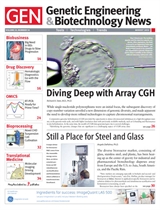Sep 4 2013
Researchers believe they have answered some questions about the role of sirtuins in enhancing longevity. Shin-ichiro Imai, M.D., Ph.D., and colleagues at the Washington University School of Medicine published a paper today ("Sirt1 extends life span and delays aging in mice through the regulation of Nk2 homeobox 1 in the DMH and L") in Cell Metabolism.
Dr. Imai's team say they have identified the mechanism by which a specific sirtuin protein called Sirt1 operates in the brain to bring about a significant delay in aging and an increase in longevity. Both have been associated with a low-calorie diet.
"In our studies of mice that express Sirt1 in the brain, we found that the skeletal muscular structures of old mice resemble young muscle tissue," said Dr. Imai. "Twenty-month-old mice (the equivalent of 70-year-old humans) look as active as five-month-olds."
Dr. Imai and his team began their quest to define the critical junctures responsible for the connection between dietary restriction and longevity with the knowledge from previous studies that the Sirt1 protein played a role in delaying aging when calories are restricted. But the specific mechanisms by which it carried out its function were unknown.
Dr. Imai's team studied mice that had been genetically modified to overproduce Sirt1 protein. Some of the mice had been engineered to overproduce Sirt1 in body tissues, while others were engineered to produce more of the Sirt1 protein only in the brain.
"We found that only the mice that overexpressed Sirt1 in the brain (called BRASTO) had significant life-span extension and delay in aging, just like normal mice reared under dietary restriction regimens," noted Dr. Imai.
The BRASTO mice demonstrated significant life-span extension without undergoing dietary restriction. "They were free to eat regular chow whenever they wished," he added.
In addition to positive skeletal muscle changes in the BRASTO mice, the investigators also observed significant increases in nighttime physical activity, body temperature, and oxygen consumption compared with age-matched controls.
Dr. Imai said that the longevity and health profile associated with the BRASTO mice appears to be the result of a shift in the onset of aging rather than the pace of aging. "What we have observed in BRASTO mice is a delay in the time when age-related decline begins, so while the rate of aging does not change, aging and the risk of cancer has been postponed."
Having narrowed control of aging to the brain, Imai's team then traced the control center of aging regulation to two areas of the hypothalamus called the dorsomedial and lateral hypothalamic nuclei. They then were able to identify specific genes within those areas that partner with Sirt1 to kick off the neural signals that elicit the physical and behavioral responses observed.
"We found that overexpression of Sirt1 in the brain leads to an increase in the cellular response of a receptor called orexin type 2 receptor in the two areas of the hypothalamus," said first author Akiko Satoh, Ph.D., a postdoctoral staff scientist in Imai's lab.
According to Dr. Imai, the tight association discovered between Sirt1-prompted brain activation and the regulation of aging and longevity raises the tantalizing possibility of a "control center of aging and longevity" in the brain, which could be manipulated to maintain youthful physiology and extend life span in other mammals as well.

 This article was reprinted from Genetic Engineering & Biotechnology News (GEN) with permission from Mary Ann Liebert, Inc., publishers. Genetic Engineering & Biotechnology News (GEN) has retained its position as the number one biotech publisher around the globe since its launch in 1981. GEN publishes a print edition 21 times a year and has additional exclusive editorial content online, like news and analysis as well as blogs, podcasts, webinars, polls, videos, and application notes. GEN's unique news and technology focus includes the entire bioproduct life cycle from early-stage R&D, to applied research including omics, biomarkers, as well as diagnostics, to bioprocessing and commercialization.
This article was reprinted from Genetic Engineering & Biotechnology News (GEN) with permission from Mary Ann Liebert, Inc., publishers. Genetic Engineering & Biotechnology News (GEN) has retained its position as the number one biotech publisher around the globe since its launch in 1981. GEN publishes a print edition 21 times a year and has additional exclusive editorial content online, like news and analysis as well as blogs, podcasts, webinars, polls, videos, and application notes. GEN's unique news and technology focus includes the entire bioproduct life cycle from early-stage R&D, to applied research including omics, biomarkers, as well as diagnostics, to bioprocessing and commercialization.